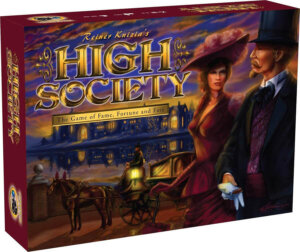
Publisher: Gryphon Games
Designer: Reiner Knizia
Genre: Card management auction game
Year: 1995; This printing 2009
Players: Three to five players
Ages: 10+
Playing time: 30 Minutes
MSRP: $25.99
High Society is an auction-based game, a very simple one at that. The game consists of a deck of money cards and a stack of tiles with the various luxury items that you can buy, plus some cards to make bad things happen. The premise is that you are part of a High Society family who wants to show how great they are by owning the best stuff. The luxury items are numbered from 1 to 10, and these numbers represent the number of status points (victory points) that they are worth. The player with the most status points at the end of the game wins.
The caveat is that if you are the player with the least amount of money you automatically lose at the end of the game. So you can have all the best stuff in the world, but if you are broke it doesn’t help you at all and you are out of the running for winner.
Each player gets a stack of money cards, 11 for each player and they are separated by colors so it is easy. Every player gets the same value cards and they will use these to bid on the luxury items that pop up. Shuffle the tiles and place face down on the table, then flip one up. Each player starts bidding on the tile using the money cards in their hand. The player who bids the most gets the tile and pays for it, the other bidders get their money back. To add some spice to the game, there are tiles that make bad things happen as well, like lose 5 status points, or lose half of your status points, or have one of your luxury tiles stolen. These use a reverse auction mechanic where the first player to drop out of the auction gets the tile, but the other players lose their bid money, not the player who dropped out. Four of the tiles have red borders, three of these are the 2x tiles, which multiplies your status points by 2 at the end of the game. After the fourth red bordered tile comes out, the game is over, so you are never exactly sure when the game is going to be over.
At the end, the player with the least money loses, and the other players figure out their status points and determine the winner.
The game plays fast and it was ok. The first time we played, the first tile out was the thief tile and no one wanted it so they kept bidding on it, which was goofy. The interesting mechanic is that once you place a bid on the table, you cant make a change on your next bid, you have to just add another money card. If the only money card you have left is 25 Million (the highest money card), you have to use it or drop out of the bidding, so card management is important to the game.
- A Dungeon Delve for Kids?: A Review of Dungeon! - Oct 24, 2022
- Better, Stronger, Faster | Descent: Journeys in the Dark Second Edition Reviewed - Oct 23, 2022
- Your Planet is Doomed!: Invasion from Outer Space Reviewed - Oct 22, 2022